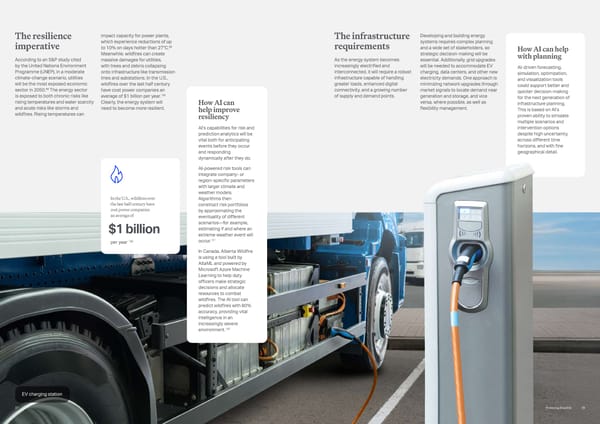The infrastructure requirements As the energy system becomes increasingly electrified and interconnected, it will require a robust infrastructure capable of handling greater loads, enhanced digital connectivity, and a growing number of supply and demand points. How AI can help with planning AI-driven forecasting, simulation, optimization, and visualization tools could support better and quicker decision-making for the next generation of infrastructure planning. This is based on AI’s proven ability to simulate multiple scenarios and intervention options despite high uncertainty, across different time horizons, and with fine geographical detail. Developing and building energy systems requires complex planning and a wide set of stakeholders, so strategic decision-making will be essential. Additionally, grid upgrades will be needed to accommodate EV charging, data centers, and other new electricity demands. One approach is minimizing network upgrades through market signals to locate demand near generation and storage, and vice versa, where possible, as well as flexibility management. EV charging station In the U.S., wildfires over the last half century have cost power companies an average of per year 100 $1 billion The resilience imperative According to an S&P study cited by the United Nations Environment Programme (UNEP), in a moderate climate-change scenario, utilities will be the most exposed economic sector in 2050.98 The energy sector is exposed to both chronic risks like rising temperatures and water scarcity and acute risks like storms and wildfires. Rising temperatures can How AI can help improve resiliency AI’s capabilities for risk and prediction analytics will be vital both for anticipating events before they occur and responding dynamically after they do. AI-powered risk tools can integrate company- or region-specific parameters with larger climate and weather models. Algorithms then construct risk portfolios by approximating the eventuality of different scenarios—for example, estimating if and where an extreme weather event will occur.101 In Canada, Alberta Wildfire is using a tool built by AltaML and powered by Microsoft Azure Machine Learning to help duty officers make strategic decisions and allocate resources to combat wildfires. The AI tool can predict wildfires with 80% accuracy, providing vital intelligence in an increasingly severe environment.102 impact capacity for power plants, which experience reductions of up to 10% on days hotter than 27°C.99 Meanwhile, wildfires can create massive damages for utilities, with trees and debris collapsing onto infrastructure like transmission lines and substations. In the U.S., wildfires over the last half century have cost power companies an average of $1 billion per year.100 Clearly, the energy system will need to become more resilient. 58 Powering Possible 57
 Powering Possible 2024: AI and Energy for a Sustainable Future Page 29 Page 31
Powering Possible 2024: AI and Energy for a Sustainable Future Page 29 Page 31